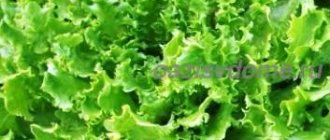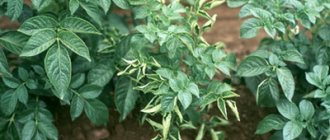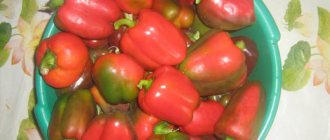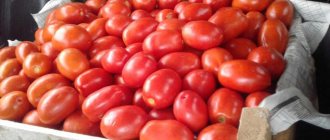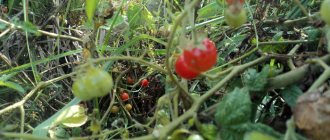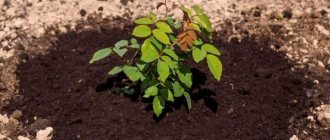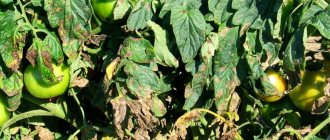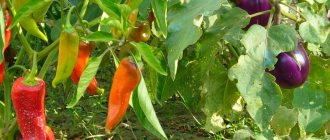Growing tomatoes in greenhouses has significant advantages over growing them in open ground. The greenhouse is most useful for gardeners in the northern regions of Russia, who do not have the opportunity to keep fruits until they are fully ripe on unprotected soil. The greenhouse allows vegetables to complete their development unhindered, despite unfavorable weather. Since each variety has its own ripening time, it is impossible to definitively answer the question of when to harvest tomatoes in a greenhouse. However, you can, based on external signs, determine the degree of readiness of the fruit with your own hands.
When to pick tomatoes in a greenhouse
Ripening time
As already mentioned, there is no exact date that you should focus on when picking tomatoes. The following factors influence the ripening time of tomatoes:
- Location of the site. Since there are areas on the territory of Russia whose climatic characteristics differ significantly from each other, it makes no sense to give uniform recommendations. If a southerner can afford to harvest at the beginning of August, then a northerner by this month will collect completely green, unfit for consumption fruits;
Greenhouses allow gardeners in the northern regions to wait for the final ripening of the fruit
- Selected variety. When planting tomatoes, you should always pay attention to their characteristics. At the moment, there is a great variety of tomatoes, conventionally divided by ripening time. Ultra-early, early-ripening, mid-early, late-ripening - all these names are not an empty phrase and serve the gardener as a guide and a hint for harvesting;
- Quality care throughout the growing season. The speed of fruit ripening is influenced not only by factors beyond the control of the gardener, but also by his own contribution to the development of vegetables. In order for tomatoes to ripen on time, it is necessary to maintain a stable temperature in the greenhouse, regularly apply fertilizer and fertilize the soil;
- Materials from which the greenhouse is made. Polycarbonate is considered one of the best materials for covering a greenhouse. It does not allow the cold to pass through and allows the gardener to leave tomatoes without fear of frostbite, even in late autumn. Also, polycarbonate is not subject to rapid rotting and lasts for more than one season, unlike less reliable film. You should also take into account the presence or absence of heating in your greenhouse, which prolongs the life of the tomatoes.
In order to get a good harvest, you need to care for your tomatoes as they grow.
If we talk about the exact ripening time, then for different varieties it can vary from 80 to 120 days. We will talk about some varieties of tomatoes and their characteristics in the next section.
The ripening time of a tomato depends significantly on its variety.
Collection of different varieties of tomatoes
Despite the fact that it is not possible to cover all the variety of tomato varieties, we will consider the most popular options and the time it takes for them to ripen.
Table 1. Tomato varieties and timing of their ripening
| Variety | Maturation | Description |
| Altai masterpiece | Mid-season variety, ripening three and a half months after planting | Depending on growing conditions, it reaches one and a half meters in height in open soil and about two meters in greenhouse conditions. On average, the fruits of this variety weigh 400 grams at ripening. During growth, it is advisable to tie several stems to a support to secure the plant |
| The leader of the Redskins | An early ripening variety that takes less than three months to fully ripen | The fruits have strong immunity and are not prone to disease. The weight of a ripe tomato of this variety is half a kilogram. The leader of the redskins is not susceptible to cracking due to temperature changes and tolerates transportation well. Has a sweet and rich taste |
Magma | A mid-early variety, the end of the growing season occurs three and a half months after sowing | The bushes of the plant reach 120 centimeters in height and are perfect for growing in open ground, but they also grow well in a greenhouse. The variety produces excellent yields, and the average weight of one fruit is eight hundred grams. However, to achieve tomatoes of this size, it is necessary to monitor the amount of ovary |
| Beef Pink Brandy | A late-ripening variety that requires at least four months of careful care from the gardener | The reward for your efforts will be the weight of the fruit, reaching one kilogram. Under good conditions, bushes of this variety grow up to two meters in length. Despite their size, these tomatoes tolerate transportation well and can be stored for a long time. Well suited for salads and have a very unusual taste, reflected in the name |
Heart Biden | Mid-early variety, ripening within more than three months | They are distinguished by their resistance to low temperatures, which is why they are often grown in open ground. The average weight of a ripe fruit is close to one kilogram. Tomatoes of this variety are valued for their sweet taste and are actively used for making juice. Consumed both raw and dried |
Honey-sugar | Mid-early variety, ripening within one hundred and ten days from the moment of first shoots | With proper care, adult bushes grow up to one and a half meters in length. The main feature of the variety is its thin stems, which are recommended to be fixed to avoid damage under the weight of the fruit. The dense peel allows you to move tomatoes without harming them. This variety is intended for greenhouse cultivation, but can also take root in open ground. |
How to prepare seeds?
First, they must be disinfected and soaked in a special nutrient liquid. Disinfection is required before planting your own seeds. They are wrapped in soft cloth and placed in potassium permanganate dissolved in water for a quarter of an hour. Then you need to rinse the seeds in water.
To increase germination and additional nutrition, their seeds are soaked for 24 hours in the juice of a houseplant - aloe. It is diluted with melt water in equal proportions. The best option for such a procedure is a leaf from a three-year-old plant. Place it in the refrigerator for one week, chop it finely and squeeze out the juice.
For similar purposes, a solution of ash (one teaspoon of ash is needed per 200 ml of water) or special biologically active agents (Baikal EM1 or Fitosporin-M) is suitable.
Hardened seeds will more easily withstand unfavorable conditions. Therefore, the owner will receive the harvest earlier. When the seeds swell, they are placed in the refrigerator for 8 hours and taken out to continue to keep the room warm. When shoots appear from the seeds, you need to plant them in the ground. It is important that the roots are still very small: this will prevent possible damage.
When to harvest tomatoes in a greenhouse?
Tomato harvesting has its own key features. If in open ground it is recommended to wait until the onset of frost in order to achieve the greatest ripeness of the fruit, then greenhouse conditions require different rules. In order for the tomato to subsequently last longer, it is necessary to remove it from the bush a little unripe so that it has time to ripen in the cellar or any other storage.
Depending on the purpose, tomatoes are collected both ripe and green.
It is allowed to wait for tomatoes to fully ripen in three cases:
- There are varieties that, due to their structure, do not facilitate easy extraction of unripe fruits. Pulling out green tomatoes with force will only harm the bush, so the best solution would be to wait until the day when the berries can be removed without unnecessary effort;
- If in the future you need seeds of ripening fruits for seedlings, then you need to extract them only from fully ripened plants. From underdeveloped seeds, tomatoes will grow much worse, if they can take root in the soil at all;
Seeds of only ripe fruits are suitable for further seedlings.
By the way! For any upcoming transportation of fruits, transportation from the dacha, and so on, unripe fruits should be collected, since their peel is tougher and saves the fruit from most potential mechanical damage.
In order for tomatoes to ripen faster and not be damaged during further storage, it is necessary to take care of the proper condition of the soil from which the bushes grow. Below we tell you how to process purchased soil and create your own.
Preparing the soil for planting tomatoes
Prices for seeds of different varieties of tomatoes
tomato seeds
Frozen tomato bushes
Closer to October, frosts come to the Urals. Until this moment, you need to collect all the tomatoes that remain on the plants.
These photographs were taken on October 2, 2022. Tomatoes in an unheated polycarbonate greenhouse, frozen at -10 degrees outside. It was about -8 degrees in the greenhouse.
After such freezing, all that remains is to cut the bushes and put them in compost. If the plants were sick, remove them as far from your site as possible. Burn if possible.
The tomato growing season can be considered closed.
Features of tomato harvesting
Greenhouse heating plays a significant role in harvesting. If the gardener has the ability to control the temperature in a given room, then there are no obstacles to the year-round harvesting of ripening fruits.
The presence of a built-in heating system allows the gardener not to depend on the weather when harvesting
If your greenhouse is not equipped with heating and depends on the weather outside, then you should focus on the following tips:
Tomatoes on branches ideal for sale
If tomatoes take a long time to ripen, the gardener can increase the flow of nutrients to the berries
Video - Details of tomato harvesting in a greenhouse
What soil is suitable for seedlings?
The soil should be rich in nutrients and light. Its quality determines the survival rate of crops. Well-known manufacturers sell ready-made soil. To make your own soil, you need to mix:
- vermicompost;
- peat;
- well-rotted compost;
- turf;
- sand;
- wood ash (200 ml per 10 kg).
Before the procedure, all ingredients should be thoroughly sifted.
When using soil from your own garden, the mixture must be disinfected with potassium permanganate, by steaming or calcination, and use the Baikal EM1 or Fitosporin-M product to restore the microflora and improve the protective forces of future plants.
Degrees of ripening of tomatoes
Each tomato goes through several stages during its development period, which will tell the gardener the condition of the fruit better than any approximate dates. Tomatoes are distinguished by the fact that they can be used for cooking in almost any condition, but each such condition requires its own approach.
Unripe tomato gaining weight
Unripe tomatoes are easily recognized - their dimensions are significantly smaller than the standard for a particular variety. The color of such fruits is usually dark green, they are elastic and hard to the touch. It is recommended to leave unripe tomatoes on the bush until their skin begins to gradually lighten. The use of such tomatoes is simply unprofitable, due to the fact that they have not yet reached their full size.
An unripe tomato can be distinguished not only by color, but also by its modest dimensions
Tomato that has reached milky ripeness
The appearance of the milky-ripe fruit does not inspire doubt - the whitish tint of the skin indicates that the berry is clearly not ready for use. However, if you cut the fruit, you will see a pink center, which is an indicator of the onset of milk ripeness. This stage is ideal for moving the fruits to the cellar for ripening. As a rule, tomatoes of this condition require about two and a half weeks to ripen.
Due to the recognizable milky hue of the peel, this stage got its name
Tomato that has reached blanzhesky ripeness
The condition of blanzhe ripeness involves coloring the tomato in a rich orange-brown hue. This tomato is hard to the touch, elastic and has almost reached the optimal dimensions for its variety. Fruits that have reached blanzhesky ripeness should be moved to the cellar. However, unlike milky ripeness, blanzhevoy requires less time for ripening. One week is enough for the fetus to reach maturity.
With proper care, tomatoes at the blanzhe stage reach ripe condition in a week
Ripe tomato
The final color of tomatoes depends on their type. In addition to red, there are pink, yellow and even purple varieties. A universal sign is the characteristic shine of the fruit peel. The life of ripe tomatoes is short. They are used for cooking raw or canned as quickly as possible to avoid massive rotting of the berries.
Signs of maturity
The timing for harvesting ripe tomatoes varies greatly. Ripening depends on the variety of tomato, as well as the growing conditions. In our climatic conditions, it is advisable to plant early ripening varieties, the harvest of which is carried out as early as possible.
Pink tomatoes have colorless skin and red flesh when ripe.
It must be remembered that the manifestation of the external color of tomatoes in a greenhouse or open ground is based on the pigmentation of the tomato pulp and the skin of the fruit itself. Pink tomatoes have colorless skin and red flesh when ripe, while red tomatoes can be harvested when the yellow skin covers the already red flesh.
Other genotypes of tomatoes are also planted in the greenhouse, but most gardeners prefer when the harvest is represented by uniformly red-colored fruits. The process of carotenoid biosynthesis is characterized by a high level of sensitivity to temperature indicators. When the temperature exceeds twenty-five degrees, lycopene is inhibited and the first fruits can be picked completely red. For the biosynthesis of B-carotene, temperature is not so important and its presence can be observed even in green tomatoes.
In a polycarbonate greenhouse, you can easily get a harvest of red tomatoes, which is due to the optimal temperature conditions. Tomato ripening occurs as a result of changes in the ratio between lycopene and B-carotene, and correctly maintained temperature in a polycarbonate greenhouse allows this process to proceed as efficiently as possible.
In a polycarbonate greenhouse you can easily get a harvest of red tomatoes, which is due to the optimal temperature conditions
You can understand how much time it takes to ripen after assessing the characteristics of the variety and its adaptability to weather conditions in the growing region. Of course, you can also harvest green tomatoes, but it is more correct and practical to harvest the crop after it is fully ripe. To this end, you can speed up the ripening of fruits in several ways.
Ripening tomatoes
Ripening is an integral part of storing tomatoes for many gardeners, as it allows them to extend their shelf life to two and a half months. For comfortable ripening, tomatoes will need the following conditions:
- The most important nuance in extending the ripening period is adjusting the temperature in storage. It should not rise above ten to twelve degrees for green-ripe specimens. Ripe tomatoes will need zero temperatures to maintain their quality. It should be remembered that some tomatoes can be susceptible to rotting even at low temperatures;
Fruits of different degrees of ripeness are not recommended to be stored next to each other.
The greater the distance between the fruits, the better they are ventilated.
Sorting is carried out not only based on damage, but also by variety
Important! Before ripening, it is necessary to carefully examine and sort all the tomatoes. Only those fruits that have no signs of mechanical damage, diseases or cracks are allowed for both short-term and long-term storage. During storage, the stalk should be separated only if it comes off easily.
Harvest time
Regular harvesting of fruits is very important for obtaining a high-quality harvest. Fruits must be picked at the stage of technological maturity of tomatoes, which is divided into the following stages:
- partial ripening of fruits;
- full ripeness of the fruit.
The fruits, pink when cut, are already quite suitable for eating. Selective harvesting at partial maturity can significantly increase the total yield. Tomatoes that are overripe on the bushes lose their taste and reduce overall yield. The saturated green fruits can be left on tomato bushes until the first days of September.
The earliest harvesting of greenhouse tomatoes involves the use of early-ripening and ultra-early-ripening varieties
Late blight
Unfortunately, when growing tomatoes, gardeners often encounter such an unpleasant phenomenon as late blight. It also happens that the disease manifests itself only during storage. Late blight refers to fungal spores that annually infect many bushes with fruits. First, the fungus invades the leaves, which gradually dry out and turn brown. If these primary symptoms are ignored, the disease spreads to the berries, rendering them unusable.
Late blight appears as brown spots penetrating into the fruit
Treatment and prevention
Despite the fact that this disease cannot be treated, it can be contained using the following measures:
- Garlic spray. Mushrooms quickly die under the influence of garlic, so this method works flawlessly. In order to make such a composition, you need to mix one and a half glasses of crushed heads of garlic, a couple of grams of potassium permanganate and ten liters of water. The resulting composition is first distributed before the formation of the ovary, the second - ten days later. Further preventive spraying is carried out every two weeks;
Crushed garlic kills fungal pathogens and prevents relapse of the disease
The saline solution protects the bush not only from fungus, but also from other infections
Fermented kefir enhances its effect compared to fresh
Tips for storing tomatoes
In addition to the generally required conditions that prolong the life of fruits, there are a number of tricks, the use of which simplifies the storage of tomatoes:
- To protect against rotting processes, it is advisable to cover the tomatoes with Vaseline or paraffin. These substances gently envelop the surface of the tomato and prevent the proliferation of pathogenic bacteria inside it, serving as reliable protection;
On average, tomatoes coated with Vaseline are stored and preserved better.
Storing tomatoes in several layers without protection in the form of straw or sawdust is very limited in time
Tomatoes can crack both during ripening and subsequent improper storage.
A controversial point during storage is the removal of the stalks. Some gardeners unanimously say that removal is necessary, otherwise the stalk will take some of the juices for itself, worsening the condition of the berry. At the same time, by removing the stalk, we make the berry more vulnerable to various infections. It is impossible to give unambiguous advice in this situation, because each gardener is guided by his own individual experience.


